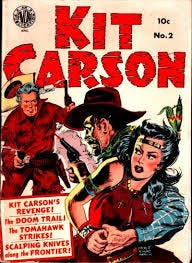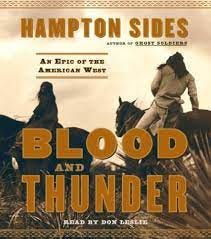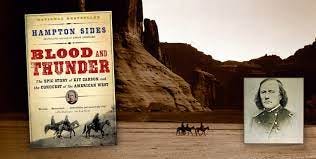A PAGE-TURNING EPIC of the AMERICAN WEST
The real Kit Carson, the real story of Western expansion.
BLOOD and THUNDER An Epic of the American West
By Hampton Sides
While I read Blood and Thunder, two words kept coming to mind: rip-roaring.
On the simplest level, this is a biography of the legendary Kit Carson. But it’s so much more. A page-turner from start to finish, B and T details the era from 1840 to the 1860s. It’s a time of Manifest Destiny and the tumultuous western expansion. President James Polk had a single obsession: at any cost, expand the American empire from coast to coast, and absorb the Southwest and California into the United States.
Blood and Thunder chronicles this American expansion, with Kit Carson at the heart of it, seemingly every step of the way. But it’s so much more than a biography of Christopher “Kit” Carson. This is a book about Armies (both Union and Confederate), many Indian tribes and their chiefs, a relatively barren and unexplored land, frontiersman, settlers and land-grabbers, explorers, The Spanish presence in native Mexico, expansionist policies in Washington DC, and cultural diversities, all colliding together. It's utterly fascinating.



Author Hampton Sides has a BA in history from Yale, and you can tell. He’s written a nonfiction book that reads like fiction, packed with riveting anecdotes, usually woven around Kit. Everyone's heard of Kit Carson. Yet few know the extent of his involvement in the Army, western exploration and expansion, and the wars with Mexico and the American Indians. Kit Carson enjoyed great fame during his lifetime. He was the preeminent authority on the unmapped and uncharted reaches of the mountain and desert West. Celebrated on a national and international level, he enjoyed a far greater reputation than Buffalo Bill, Wild Bill Cody, Wyatt Earp, or Daniel Boone. He was a superstar who could neither read nor write, yet spoke seven Indian languages. He was sought after as a scout, had the ear of many generals, and sat with presidents. He married Indian women and was a husband, a dad, a cowboy, guide, tracker, Indian fighter, Lieutenant Colonel, hunter, explorer, scout, dead-eye rifle shot, battle commander, and over and over, death-defier. While he married not one but two Indians, he was also an army Lieutenant Colonel who followed orders, which included killing.
Besides so much about Kit, B and T also contains many mini-biographies. John Fremont, the cunning major who led the march across California; General Kearney, the foremost frontier officer in the West, who led the Army of the West with the (secret!) goal to sweep into Santa Fe, drive out the Spanish and Mexico, and continue on to California; Narbona and Manuelito, the Navajo Chiefs who resisted valiantly and fought relocation; and I never knew about James Polk, the obsessive President. Some say he was the hardest working president we ever had. He was hell-bent on Manifest Destiny and acquiring California. He stayed just one term, and died weeks after he left office. That’s just the start. There are many villains and heroes here, including Kit Carson himself.
B and T is also a compressed but fascinating history of Navajo trials and tribulations. Sides remains fair and balanced: he’s neither pro-Indian nor pro-army. But he does offer a perspective that perhaps the most violent tribe in the Southwest was not the Comanche or the Apache, but the Navajo. He doesn’t filter out the brutality and bloodletting, while making it very clear that both sides were at times aggressors and peacemakers.
The initial military foray into the West is led by General Kearney in 1846. At the time, it’s the largest march ever undertaken by the United States military. From Fort Leavenworth, Kansas, into Santa Fe, on arrival the Mexicans are thrilled to see them. They assume they've come to help fight the warlike Navajos, who’ve attacked Mexican and Spanish settlers for centuries. Surprised that Santa Fe is as small and primitive as it is, and under secret orders from President Polk, Kearney pushed straight for California. With Kit’s help and knowledge, all the land from the Texas border to the Pacific Coast is seemingly acquired in just a few short years. Yet the story continues: once acquired, Americans had to settle it. The Armies and the settlers now went head-to-head with the troublesome and violent Navajos, as well as other tribes.
The Southwest in 1860. This is a part of the country that’s truly lawless and unpoliced. There are simply no rules. Indians feel free to steal crops and livestock, plunder homesteads or settlements, and even kidnap or kill pioneers. Mexicans and Indians subject one another to slavery. Settlers pour in in greater numbers every year. Dealing with the “Indian problem” becomes the focus of the Army following the Civil War. The demise of the semi-nomadic way of Navajo life is detailed through battles, instances of displacement, relocation, and failed relocation. Did you know about the Army-forced “Long Walk” of the Navajo people, into what was essentially a concentration camp? Ultimately, we see how the reservation system and current Navajo Nation was established. This part of the book, of course, reads like a tragedy.
You read Blood and Thunder to learn about Kit Carson. He wasn't just the figure we saw in elementary school picture books, the guy wearing the buckskins. He wasn’t merely a hunting guide for rich people from the East. He was an incredibly respected Lieutenant Colonel who knew more about the nuances and incredibly complicated interwoven relationships of the pioneers, the Indians, and the Mexicans. He seems to turn up at every major western movement: mapping the red-rocks and mountains, guiding the Army, overwhelming California, advising presidents, battling and ultimately making peace with the Indians.
You also read Blood and Thunder to learn about President Polk's relentless push west, how California came to be, how we acquired New Mexico and Arizona from Mexico, and how lawless and bloody the southwestern part of the country has been. We learn that Kit Carson had more to do with annexing California and the southwest from Mexico than anybody. We’re told that the Navajos were certainly not angels, and remained at a total loss as to the culture of the new white people who seemingly came from nowhere, and poured in. In this regard, the Navajos are given full voice to describe their dealings with the whites, the horrors from both sides, and the back-and-forth revenge that went on for years. I think that Blood and Thunder ably paints a picture of both sides of the American conquest, and I came away feeling that the Navajo side of things has not been told to the extent that it must. For that reason alone, this book should be read.
This is an exceptional book of history where a talented author weaves dozens of themes together. With Kit Carson generally at the center, any Hollywood cliches you may hold will likely be swept aside. If there’s one word to describe this book, it’d be Educational.. Highest recommendation, it's a great book of biography and history and many many things you didn’t know. Here's the book on Amazon.


PS. When he wasn’t commissioned or guiding, Kit Carson lived with his family on a outside Taos, New Mexico. The title, Blood and Thunder, is a term for the unauthorized dime-novels written during Carson’s lifetime, capitalizing on his fame, sensationally fictionalizing his daring-dos and exploits, mostly as an Indian fighter. Among other things, cities, mountains, rivers, schools and streets bear his name.
Thanks for reading and sharing. My 7th novel – ZIN MIGNON and the MUSTARD MONKS -- was released by Playa Chica Press earlier this month. You may find it and all my work at www.MICHAELDASWICK.com .



